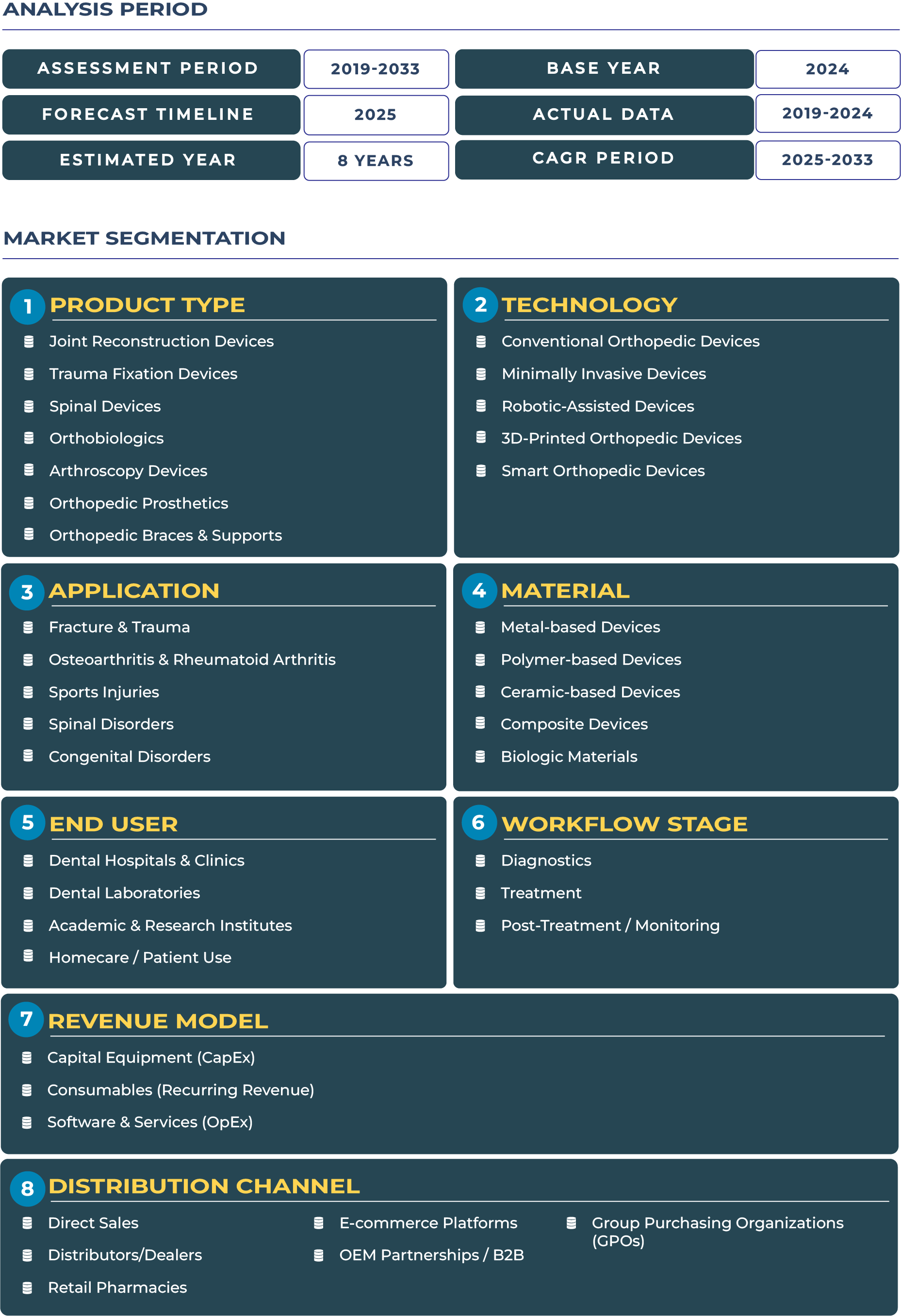Report Format:
![]()
![]() |
Pages: 110+
|
Pages: 110+
Vietnam’s Healthcare Infrastructure Expansion: The Catalyst for Orthopedic Devices Market Growth
Vietnam’s healthcare sector is undergoing rapid modernization, making it one of the most dynamic healthcare ecosystems in Southeast Asia. The government’s significant investment in hospital infrastructure, coupled with the rise of private healthcare providers, is directly fueling demand in the orthopedic devices market. With a young but rapidly aging population, Vietnam is entering a critical stage where orthopedic procedures such as joint reconstruction, trauma fixation, and spinal interventions are expected to increase. This expansion is not only improving accessibility but also creating a favorable environment for medical device companies to strengthen their presence in the country.
The Vietnam orthopedic devices industry is expected to rise from USD 465.8 million in 2025 to USD 1,148.0 million by 2033, reflecting a robust CAGR of 11.9%. This strong performance is underpinned by infrastructure upgrades, new private hospital chains, and the country’s growing surgeon capacity. With improved healthcare financing and a large patient pool transitioning into orthopedic care, Vietnam is shaping up to be one of the fastest-growing markets in the Asia-Pacific orthopedic devices landscape (DataCube Research).
Drivers and Restraints Shaping Vietnam Orthopedic Devices Ecosystem
Private hospital expansion and demographic shifts driving market momentum
One of the most influential drivers in Vietnam Orthopedic Devices sector is the rapid expansion of private hospital networks in urban centers such as Hanoi, Ho Chi Minh City, and Da Nang. These facilities are increasingly equipped with advanced surgical capabilities, including arthroscopy and spinal surgery, which accelerates the adoption of specialized devices. Furthermore, Vietnam’s large young population is gradually transitioning into middle age, with higher risks of orthopedic injuries and degenerative joint diseases. The increasing number of trained orthopedic surgeons is also strengthening procedure capacity, leading to higher adoption of implants and advanced fixation systems. Combined, these factors are creating sustained demand in the orthopedic devices industry.
Affordability challenges and regulatory constraints slowing rural adoption
Despite urban growth, challenges remain in extending access to Vietnam’s rural and provincial areas. Device penetration outside major cities is relatively low due to weak reimbursement frameworks and out-of-pocket payment burdens. Patients in provincial hospitals often face delayed access to advanced implants or prosthetics, primarily due to logistics challenges and high device prices. Additionally, longer regulatory review times create delays for international companies bringing innovations to the market. This uneven distribution of care contributes to market restraints that must be addressed for the orthopedic devices ecosystem to achieve inclusive growth across Vietnam.
Emerging Trends and Untapped Opportunities in Vietnam Orthopedic Devices Sector
Private chains and local distributors redefining the orthopedic devices landscape
Vietnam Orthopedic Devices market is witnessing new trends driven by private healthcare consolidation and the emergence of regional distributors. Private hospital chains are standardizing care models across cities, enabling consistent adoption of orthopedic prosthetics and joint reconstruction implants. At the same time, local distributors are becoming critical partners for global device manufacturers, easing entry barriers and supporting localized after-sales services. Increased inbound investment from foreign companies is further reinforcing Vietnam as a promising regional hub for orthopedic innovation and supply.
Strategic partnerships and localized models unlocking opportunities
Significant opportunities exist in partnerships with private hospital chains that dominate elective surgeries and trauma cases. Companies introducing low-cost implant programs can capture the value-sensitive patient segment while creating inclusive access to advanced care. Moreover, establishing surgeon training academies in partnership with Vietnamese medical universities can accelerate procedural adoption, especially in complex fields like spinal surgery and orthobiologics. Tiered pricing models tailored to urban and provincial healthcare systems also represent a clear path to scale. Collectively, these opportunities highlight the immense potential of the orthopedic devices industry in Vietnam’s evolving healthcare ecosystem.
Competitive Dynamics in Vietnam Orthopedic Devices Market: Global Giants and Local Partners
The competitive landscape of Vietnam Orthopedic Devices sector features a mix of multinational leaders and local distributors. Global players such as Johnson & Johnson MedTech and Zimmer Biomet have expanded their presence through partnerships with major Vietnamese hospitals, offering advanced implants and surgical systems. At the same time, local distributors play an indispensable role in bridging supply and service gaps across provinces. Companies are increasingly adopting strategies such as partnering with large private hospital chains to accelerate product adoption and reduce dependency on fragmented public procurement channels. Additionally, the introduction of cost-effective implants tailored to Vietnam’s price-sensitive market is enabling greater penetration. Continuous investment in surgeon training initiatives underscores a strategic shift from transactional sales to ecosystem development, ensuring that orthopedic devices adoption grows sustainably in Vietnam.







